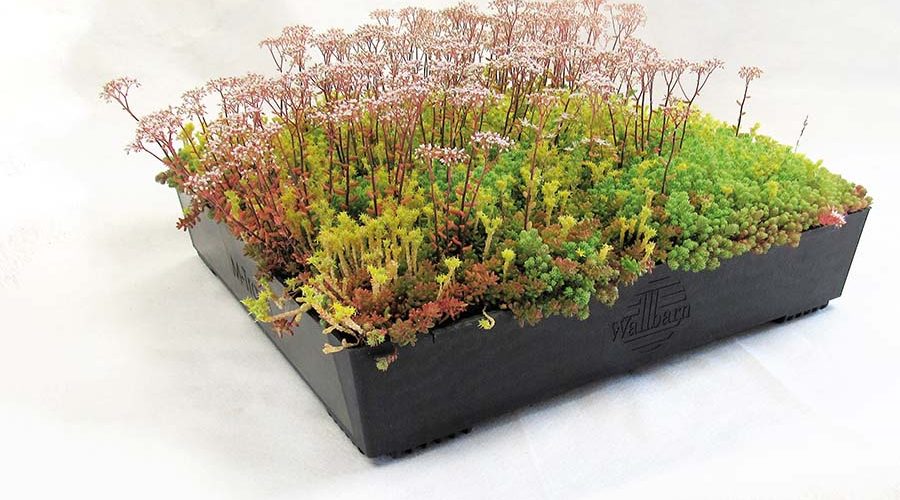Transforming unused flat roof areas into attractive green spaces is easier and quicker than many imagine and delivers a raft of benefits that are really attractive to public sector clients – from improved air quality, urban cooling and rainwater management to better learning environments with reduced noise levels for students and environments that boost mental wellbeing for building occupants, writes Julian Thurbin, Director at Wallbarn.
Wallbarn
In the UK, London leads the green roofing charge, with 42% located in the capital (2016 data), a figure largely due to the success of the Mayor of London’s Living Roofs and Walls Policy introduced 12 years ago. Other cities, including Manchester and Cambridge, are keen to make their mark in this sector and the Scottish Wildlife Trust has included green roofs in its ’50 things to happen in Scotland in the next 50 years’.
A well-executed green roof will last for years (75 and counting for one development in Germany) and require minimal maintenance. They are accepted for improving living and working environments but, importantly, planners working with the Mayor of London have also identified their worth in making locations more attractive to investors.
Traditional or modular?
Traditional extensive green roofs consist of a roll-out system which requires the installation of separate elements – generally a protection layer, root barrier, drainage layer, geotextile filter, growing medium and sedum plants.
The alternative is a modular solution containing all elements of the green roof in a robust cassette tray. This is a relatively new approach – Wallbarn has been supplying this solution for more than 10 years with a fifth-generation design currently on the market – with leading manufacturers investing heavily in research and development in order to offer a system that is straightforward to specify, install and maintain. Cassettes are pre-planted with hardy native British-grown sedum and/or perennial wildflowers, increasing biodiversity and providing a haven for pollinators. For designers and environmental campaigners asking questions about encouraging native wildlife into towns and cities, it is a perfect solution.
How can a green roof be modular?
A modular approach actually lends itself very well to this roofing style. It is a prefabricated system prepared off site and clicked into place on site to deliver an instant green roof suitable for homes, schools, hospitals, shopping centres, offices, transport hubs and retail developments – anywhere with a flat roof. Everything required is contained within the easily transportable cassettes, making it a quick, easy and clean installation. The best systems offer 100mm deep substrate specifically developed to slowly release nutrients to ensure the sedum or wildflowers are properly nourished throughout their lifetime. Trays have in-built drainage/moisture reservoirs and simply click together by hand. Importantly, any of the cassettes can be lifted should access be required to the roof deck post-installation.
Two key considerations when ordering pre-planted modular cassettes are time spent in transit and the need to unpack them within 24 hours of delivery to ensure optimum plant health. If left for too long on transport crates – we consider 48 hours the absolute maximum – enzymes begin to breakdown the plants. This is an especially critical consideration at present given the impact of COVID-19 on cross-border deliveries and the haulage industry. It is; therefore, hugely important to identify where the system is coming from and how long it will be in transit. Good suppliers will have year-round availability.
Other considerations are:
Load-bearing
The first consideration for any modular or roll-out green roof installation is assessing the load-bearing capacity of the structure. A structural engineer will provide this information. We find that our system can be retrofitted on to the vast majority of roofs given it weighs 100kg/m2 saturated. For new-build projects, the required structural integrity can be designed in.
Technical considerations
Fire regulations require a hard border between vegetation and building walls and around features such as rooflights and fall arrest systems (consult the GRO Code for further details). This is achieved with border pebbling. The roof also needs to be relatively level.
Maintenance
Sedum plants are hardy and will tolerate extreme conditions – there are green roofs worldwide thriving in a wide variety of climatic conditions. In dry conditions, it may be necessary to water the roof, but a simple irrigation system can be installed.
Design
A good supplier will design a layout guide with estimates for trays, geotextile fabric (to protect the roof membrane and act as a filtration layer) and border pebbling and provide on-going technical support.
Benefits
Green roofs are proven to improve air quality and the thermal performance of buildings (retaining heat in winter and cooling in summer), reduce the urban heat island effect and manage heavy rainfall by slowing stormwater run-off. Recent research has also shown clear evidence that they prolong the life of roof membranes due to the reduction of UV damage. And that’s in addition to the increased amenity they bring to roof spaces, the ability to ‘upgrade’ them to blue or biosolar installations and their ability to aid planning applications.
Conclusion
Green roofs are increasingly being considered an essential sustainable design consideration, and the modular approach presents a really good opportunity for more public sector clients to take advantage of the many benefits of urban greening. There is a huge push to green public spaces and many thousands of square metres of little-used flat roofs on schools, libraries, sports centres, hospitals, public and local authority buildings, even bus stops and garages. And, being modular, you can green as much or as little of the roof as you wish – or add to the planting at a future date with ease.









